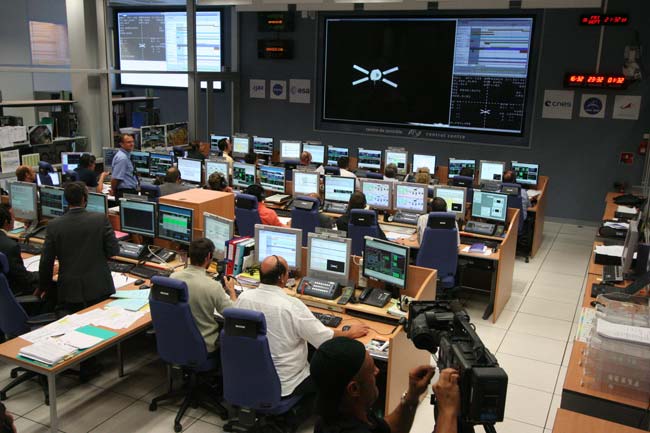European Cargo Ship Departs Space Station

A European cargoship the size of a London double-decker bus bid farewell to the InternationalSpace Station late Friday after five months docked at the orbiting laboratory.
The EuropeanSpace Agency?s (ESA) space freighter Jules Verne, the first of a new fleet ofAutomated Transfer Vehicles (ATV), undocked from the station at 5:29 p.m. EDT(2129 GMT) to begin a leisurely, 23-day descent and destruction.
Named afterthe famed 19th Century French science fiction writer Jules Verne, the $1.9billion (1.3 billion Euros) cargo ship will spend the next several weekstraveling to the proper orbit to begin its disposal by burning up in the Earth?satmosphere. Thespace freighter launched toward the space station on March 8 and docked inearly April after a series of rendezvous tests to deliver cargo and preciousmanuscripts written by its namesake author.
Jules Verneis 32 feet (10 meters) long cylinder with a width of about 15 feet (4.5 meters)and hauled almost 8 tons of cargo - three times the amount delivered aboardRussian Progress spacecraft - to the space station. Since the cargo shiparrived, station astronauts retrieved its contents, usedits spacious interior as a washroom, used its four rocket engines to boostthe station?s orbit and filled the freighter full of unneeded items and trashfor its eventual disposal.
Thespacecraft performed so well, mission managers at a control center in Toulouse,France, extended its flight by one extra month. Jules Verne is slated to bedestroyed on Sept. 29 when it burns up during reentry over the Pacific Ocean.
?How theATV has performed highlights extremely well how the benchmark of European spacetechnology has been raised, and the wealth of expertise present in Europeanindustry," said Simonetta Di Pippo, ESA?s director of human spaceflight, in astatement. ?This bodes well, not only for future ATV missions to theInternational Space Station, but also for developments of this kind oftechnology that may eventually provide Europe with an autonomous cargo returncapability and independent access to space for European astronauts.?
ESAofficials are providing at least five ATV cargo ships to resupplythe space station in return for launch services for its Columbus laboratorydelivered to the space station this year, as well as slots for Europeanastronauts on future long-duration missions to the orbital research lab.
Get the Space.com Newsletter
Breaking space news, the latest updates on rocket launches, skywatching events and more!
Jules Verneis the second cargo ship to leave the space station this week. The Russianspace freighter Progress 29 castoff from the station on Monday and will reenter the Earth?s atmosphere fordisposal next week.
The nextATV is slated to fly in 2010 and will follow the debut of another space stationcargo ship, Japan?s H-2A Transfer Vehicle, set for next year.
?Eventhough our schedule has been very busy at the ATV Control Centre, I couldn?thave wished for a better mission," said Herv? C?me, ESA?s ATV Jules Verne leadmission director. ?And in just over three weeks, we will be looking forward tothe ATV 2 mission in 2010.?
Join our Space Forums to keep talking space on the latest missions, night sky and more! And if you have a news tip, correction or comment, let us know at: community@space.com.

Tariq is the Editor-in-Chief of Space.com and joined the team in 2001, first as an intern and staff writer, and later as an editor. He covers human spaceflight, exploration and space science, as well as skywatching and entertainment. He became Space.com's Managing Editor in 2009 and Editor-in-Chief in 2019. Before joining Space.com, Tariq was a staff reporter for The Los Angeles Times covering education and city beats in La Habra, Fullerton and Huntington Beach. In October 2022, Tariq received the Harry Kolcum Award for excellence in space reporting from the National Space Club Florida Committee. He is also an Eagle Scout (yes, he has the Space Exploration merit badge) and went to Space Camp four times as a kid and a fifth time as an adult. He has journalism degrees from the University of Southern California and New York University. You can find Tariq at Space.com and as the co-host to the This Week In Space podcast with space historian Rod Pyle on the TWiT network. To see his latest project, you can follow Tariq on Twitter @tariqjmalik.









